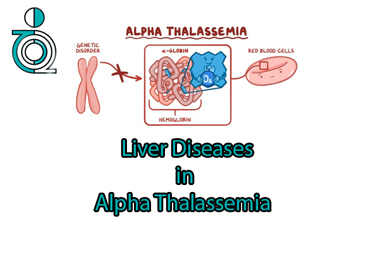
2025-09-27
Liver Diseases in Alpha Thalassemia
Hemoglobin H disease (HbH disease) was traditionally considered a relatively mild disorder, and the common belief was that most patients would not experience serious liver complications throughout their lifetime. However, new evidence shows that this perception is not entirely accurate. In fact, the liver, as the primary organ for iron storage in the body, is highly vulnerable to damage in HbH patients. Even in patients who do not receive regular blood transfusions, iron gradually accumulates in the liver over time, potentially leading to serious complications.
The main mechanism of this liver injury is linked to a phenomenon called ineffective erythropoiesis. In HbH, the bone marrow produces a large number of blood cells in an attempt to compensate for anemia, but many of these cells remain immature and are destroyed. This process releases excess iron into the bloodstream. Such iron exists as non-transferrin-bound iron (NTBI) and directly enters liver cells. As a result, hepatocytes undergo inflammation, oxidative stress, and ultimately fibrosis. If this process continues, the patient may later develop cirrhosis and its associated complications, including liver failure and hepatocellular carcinoma (HCC).
The situation becomes even more complicated in patients with HbH who require frequent blood transfusions, particularly those with non-deletional HbH. These patients not only suffer from iron overload due to ineffective erythropoiesis but also from transfusion-related iron accumulation. This dual burden significantly increases the likelihood of liver complications. Furthermore, the risk of viral hepatitis B and C is always present, as blood transfusions—especially in regions where full blood screening standards are not strictly followed—can be a route of transmission. Chronic viral hepatitis dramatically accelerates fibrosis progression toward cirrhosis.
Recent epidemiological studies have shown that more than 70% of HbH patients, even those who do not require transfusions, develop some degree of hepatic iron overload. This finding underscores the importance of close and continuous monitoring. Age is also a major risk factor; patients reaching their 30s and 40s are at greater risk of clinical consequences from iron overload. Therefore, HbH can no longer be regarded as merely a “benign” disease but must instead be recognized as a chronic condition requiring lifelong monitoring.
Diagnosis
Diagnosing and monitoring liver damage in these patients requires a multifaceted approach. On one hand, laboratory tests such as serum ferritin measurement should be used, although ferritin can be influenced by other factors and is not always reliable on its own. On the other hand, MRI T2* imaging allows for a more direct measurement of hepatic iron and is now considered the gold standard. To assess fibrosis and liver structure, non-invasive methods such as transient elastography and regular ultrasound examinations are recommended. In addition, patients should undergo annual testing for viral hepatitis B and C to ensure early treatment if infected.
Treatment
Management of liver disease in HbH consists of several components. The most important intervention is the use of iron chelation therapy with agents such as deferoxamine, deferiprone, and deferasirox. Evidence suggests that these drugs not only reduce hepatic iron concentration but can also gradually improve liver function and even decrease fibrosis levels. Although most clinical data comes from patients with β-thalassemia, the similarities in pathophysiology justify applying these findings to HbH patients.
Treatment of viral hepatitis also plays a critical role. In the past, interferon and ribavirin produced unsatisfactory results and were associated with many side effects. In recent years, however, direct-acting antivirals (DAAs) such as sofosbuvir/velpatasvir or sofosbuvir/ledipasvir have revolutionized hepatitis C treatment. With cure rates exceeding 95% and high safety profiles, these drugs have greatly improved the prognosis of thalassemia patients with hepatitis C. For hepatitis B, medications such as tenofovir and entecavir are effective in suppressing the virus and reducing the risk of progression to cirrhosis and HCC.
Despite these interventions, some patients may still progress to cirrhosis. In such cases, management should involve close collaboration with hepatology specialists. Patients with cirrhosis require regular six-month surveillance with ultrasound and alpha-fetoprotein testing to detect liver tumors at early, treatable stages. Importantly, HCC is not limited to cirrhotic patients; cases of cancer have been reported even in the absence of cirrhosis. Therefore, especially in older patients with high iron burden, enhanced vigilance is required.
Key Recommendations for Better Management of HbH Patients:
Regular monitoring of liver iron burden with MRI or ferritin,
Referral of patients with evidence of liver disease to relevant specialists,
Prompt and effective treatment of viral hepatitis,
Vaccination against hepatitis A and B,
Proper management of anemia and ineffective erythropoiesis to minimize additional iron entry into the body.
Together, these measures can help reduce the burden of liver disease in HbH patients and improve both their quality of life and life expectancy.
Compiled by: Majid Taherian
Source: TIF (Thalassemia International Federation)
/End of message
Charity Foundation of Special Disease
@cffsd